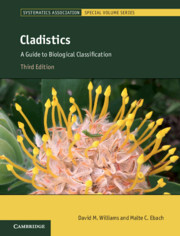Book contents
- Cladistics
- The Systematics Association Special Volume Series
- Cladistics
- Copyright page
- Dedication
- Contents
- Preface
- Acknowledgements
- Introduction: Carving Nature at Its Joints, or Why Birds Are Not Dinosaurs and Men Are Not Apes
- Part I The Interrelationships of Organisms
- Part II Systematics: Exposing Myths
- Part III The Cladistic Programme
- Part IV How to Study Classification
- Part V Beyond Classification
- 13 Beyond Classification: How to Study Phylogeny
- 14 The Separation of Classification and Phylogenetics
- 15 Further Myths and More Misunderstandings
- Afterword
- Index
- Systematics Association Special Volumes
- References
13 - Beyond Classification: How to Study Phylogeny
from Part V - Beyond Classification
Published online by Cambridge University Press: 20 July 2020
- Cladistics
- The Systematics Association Special Volume Series
- Cladistics
- Copyright page
- Dedication
- Contents
- Preface
- Acknowledgements
- Introduction: Carving Nature at Its Joints, or Why Birds Are Not Dinosaurs and Men Are Not Apes
- Part I The Interrelationships of Organisms
- Part II Systematics: Exposing Myths
- Part III The Cladistic Programme
- Part IV How to Study Classification
- Part V Beyond Classification
- 13 Beyond Classification: How to Study Phylogeny
- 14 The Separation of Classification and Phylogenetics
- 15 Further Myths and More Misunderstandings
- Afterword
- Index
- Systematics Association Special Volumes
- References
Summary
Haeckel’s genealogical project began in 1866 with his monumental two-volume Generelle Morphologie der Organismen (Haeckel 1866), written partly under the influence of Darwin’s Origin of Species (Darwin 1859), terminating some 30 years later with another equally exhaustive survey – this time in three volumes: Systematische Phylogenie: Entwurf eines natürlichen Systems der Organismen auf Grund ihrer Stammesgeschichte (Haeckel 1894–18961).
- Type
- Chapter
- Information
- CladisticsA Guide to Biological Classification, pp. 353 - 368Publisher: Cambridge University PressPrint publication year: 2020

